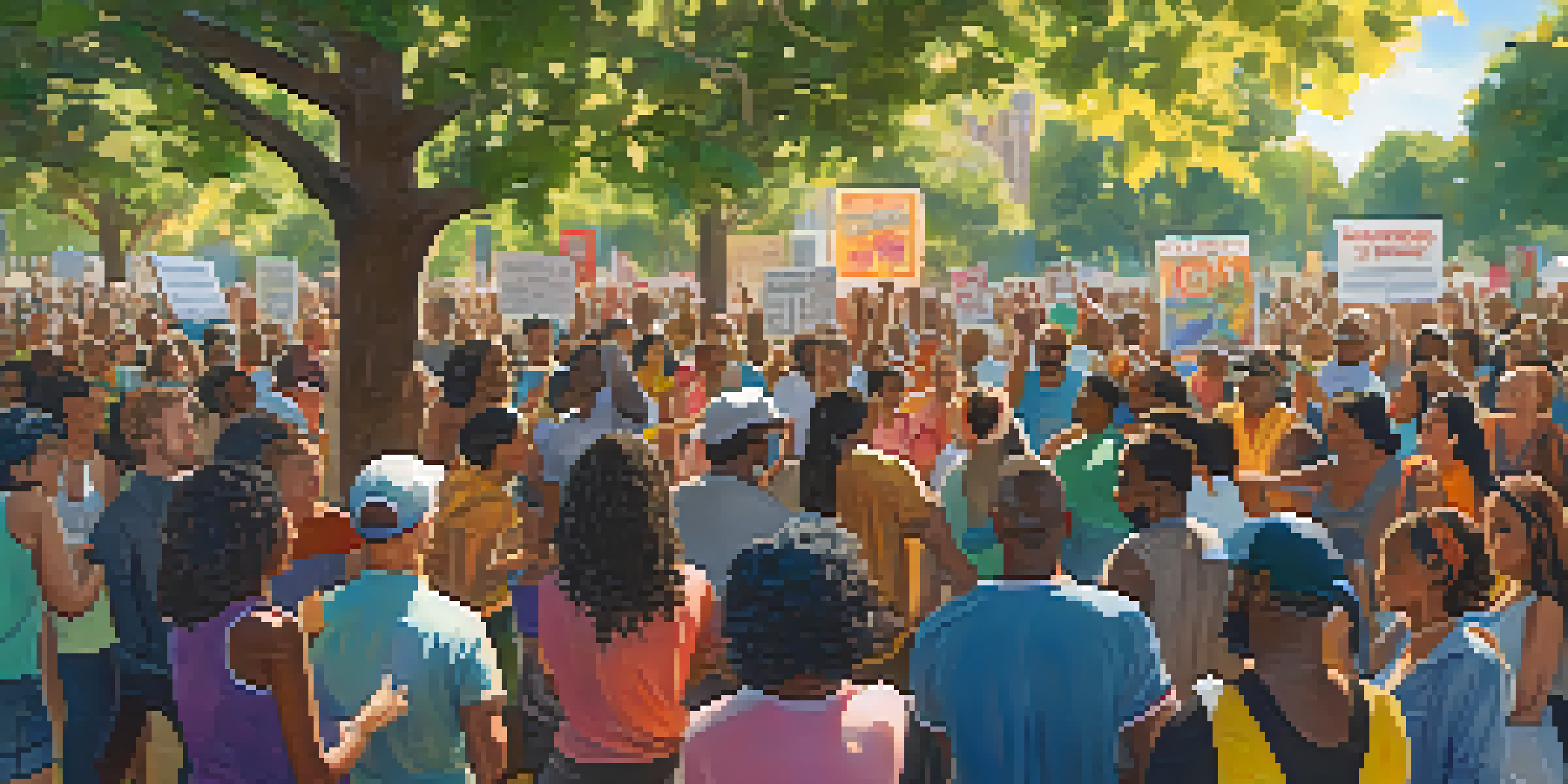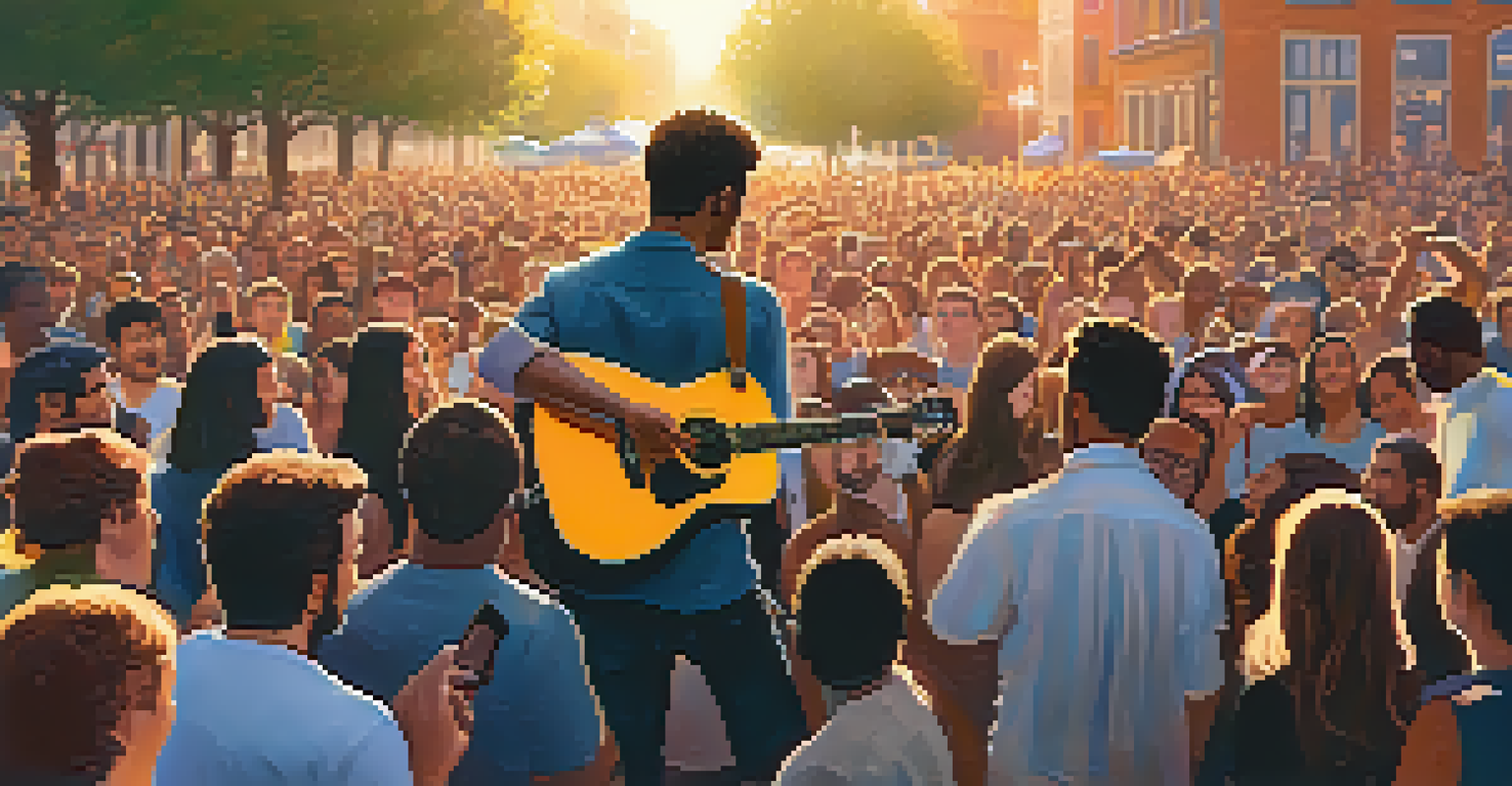The Use of Music in Nonviolent Protest Movements

The Historical Context of Music in Protests
Music has long played a pivotal role in social movements, serving as a rallying cry for change. From the civil rights movement in the 1960s to the anti-apartheid struggle in South Africa, songs have helped to unify diverse groups of people. These melodies often capture the hopes and frustrations of those involved, making them powerful tools for communication and solidarity.
Music is the universal language of mankind.
During the civil rights era, for instance, songs like 'We Shall Overcome' became anthems of resilience and hope. They provided not only a soundtrack to the movement but also a sense of belonging among participants. This historical context underscores how music can transcend barriers, conveying messages that resonate deeply with listeners.
As we look at these movements, it's clear that music is not just background noise; it's an integral part of the fabric of protest. The emotional weight carried by these songs often inspires individuals to join the cause, reinforcing the idea that music can be a catalyst for social change.
Music as a Tool for Unity and Identity
One of the most significant roles music plays in nonviolent protests is fostering unity among participants. When people sing together, they create a shared experience that strengthens their collective identity. This sense of belonging can be especially powerful in diverse groups, helping to bridge cultural and social divides.

For example, during the Women's March in 2017, songs like 'Respect' by Aretha Franklin echoed through the crowds, uniting voices from all walks of life. This shared musical experience not only amplified their message but also fostered a sense of camaraderie among participants. In this way, music becomes a universal language that speaks to the heart of the movement.
Music Unites Protesters and Causes
Songs create a shared experience that fosters unity and strengthens collective identity among diverse groups in protests.
Moreover, the act of singing together can boost morale and sustain energy during long protests. It transforms a moment of struggle into one of joy and resilience, reminding participants of their shared goals and the power of their voices.
The Emotional Impact of Protest Music
Music has a unique ability to evoke emotions, making it an effective tool for nonviolent protest movements. Songs can express feelings of anger, hope, sadness, and joy, allowing participants to channel their emotions constructively. This emotional resonance often drives individuals to take action, making them feel more connected to the cause.
The power of music makes all the difference in the world—it's a force that can unite, inspire, and ignite change.
Consider the song 'Fight the Power' by Public Enemy, which became an anthem for social justice. Its powerful lyrics and driving beat inspire listeners to confront injustice head-on. The emotional impact of such music can mobilize people, encouraging them to join protests and stand up for their beliefs.
Additionally, the emotional connection fostered by music can create lasting memories for participants. These shared moments of passion and determination become part of the collective narrative of the movement, solidifying its significance in history.
The Role of Lyrics in Shaping Messages
The lyrics of protest songs often convey powerful messages that resonate with the struggles of the people. They can articulate the injustices faced by individuals and communities, serving as a call to action. These words not only inspire but also educate listeners about the issues at hand, making the case for change.
For example, Bob Dylan's 'The Times They Are A-Changin'' captures the spirit of social upheaval and the need for reform. Its lyrics encourage listeners to embrace change and challenge the status quo. By distilling complex social issues into relatable themes, such songs make the message accessible to a broader audience.
Emotional Power Drives Activism
Protest music evokes emotions and inspires individuals to take action by channeling feelings of hope, anger, and resilience.
Moreover, the repetition of key phrases in protest songs can help reinforce the movement's goals. When participants chant or sing these lyrics, they internalize the message, strengthening their commitment to the cause.
Cultural Significance of Protest Music
Protest music often reflects the cultural landscape of its time, capturing the zeitgeist of a movement. It can draw from various musical genres, incorporating local traditions and influences to create a unique sound that resonates with participants. This cultural significance adds depth to the protest, making it more relatable and engaging.
For instance, the folk music revival of the 1960s included artists like Joan Baez and Pete Seeger, whose songs highlighted social injustices while honoring traditional styles. By blending cultural heritage with contemporary issues, these musicians created a rich tapestry of sound that spoke to the heart of the movement. This connection to cultural roots can enhance the emotional impact of the music.
Furthermore, the cultural significance of protest music can transcend geographical boundaries. Songs that resonate with one community can inspire others around the world, creating a global dialogue about social justice.
Modern Examples of Music in Nonviolent Protests
In recent years, we’ve seen numerous instances where music has played a crucial role in nonviolent protests. The Black Lives Matter movement, for example, has embraced songs that speak to issues of racial injustice and police brutality. Artists like Kendrick Lamar and Beyoncé have used their platforms to shine a spotlight on these struggles, inspiring a new generation of activists.
During protests, participants often use popular songs as anthems, remixing lyrics to fit their messages. These adaptations allow the music to evolve with the movement, making it feel fresh and relevant. This dynamic relationship between music and protest keeps the spirit of the movement alive and encourages ongoing engagement.
Lyrics Amplify Messages for Change
The powerful lyrics of protest songs articulate injustices and serve as calls to action, making complex issues accessible to a broader audience.
Additionally, social media has amplified the reach of protest music, allowing songs to go viral and inspire action beyond local communities. Platforms like TikTok and Instagram have become spaces for activists to share their favorite protest songs, creating a sense of unity that transcends physical boundaries.
Challenges and Limitations of Music in Protests
While music is a powerful tool in nonviolent protests, it also faces challenges and limitations. One significant issue is the commercialization of protest music, which can dilute its message. When songs become popular in mainstream culture, the original intent may be lost, and the music can be co-opted by those who do not share the movement's values.
Moreover, not all music resonates equally with participants. Personal preferences and cultural differences can affect the impact of a song within a diverse group. It's essential for organizers to be mindful of these factors to ensure that the music they choose truly reflects the sentiments of the movement.

Finally, the effectiveness of music in protest can be influenced by external factors, such as government responses or media coverage. If protests are met with violence or suppression, the music may struggle to achieve its intended impact, highlighting the complex interplay between art and activism.